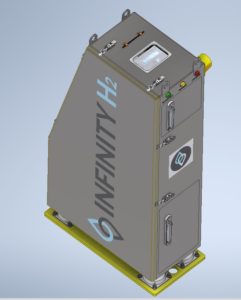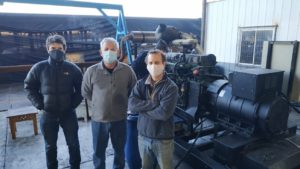Mines with large diesel-powered haul truck fleets are looking to the future of zero emissions operation with new technologies like battery electric but for now they want to make inroads with decarbonisation with their existing fleets. One option for doing this is hydrogen (more specifically hydrogen and oxygen mixture, HHO, gas) produced from electrolysis which is injected into the combustion process, to increase combustion efficiency and reduce fuel consumption.
Ed Grimm, Founder and CTO of Infinity H2 (left) and Cristian Bowen, Executive Director – Public & Special Affairs


One of the innovators in this area is Chilean company Infinity H2 based in Santiago. Cristian Bowen, Infinity H2 Executive Director – Public & Special Affairs told IM: “Hydrogen is injected into the engine just before the turbo – we use a pressurised tank to be able to deliver the hydrogen in this way. We have found that this results in fewer losses with the hydrogen production from the electrolysis, in other words more efficient. I would also say that our unit is more compact, lighter weight but also more heavy duty than other which have been marketed for mining trucks – we have seen this directly at Codelco Radomiro Tomic where our system was being tested in parallel at the same time as the competitor’s design.”
Both Infinity H2 and competitor technologies are using electrolysis – there is no patent on that as a process. But beyond that its solution it says has unique attributes that are patented. “Ed Grimm, the Infinity H2 Founder and CTO, has been working on refinement of the technology for mining application for the past 30 years – his patents relate to the actual electrolysis plates which have a particular innovative configuration that allows the unit to be smaller in size; as well as the way in which their plastic EDP coating is arranged. It also relates to how we modulate the production of HHO depending on the rate of fuel consumption – all this is specific to our solution.” Bowen says it gets this information directly from specific sensors in the engine without having to go through the truck OEM data analysis system, which can be problematic due to interoperability issues.
A 3D render of the latest Infinity H2 unit design

Infinity H2 also has an important collaborator in the US – Infinity Industrial Controls in Tampa, Florida, where Ed Grimm is also CTO. Plus DICTUC, a leading engineering consultancy at the Universidad Católica de Chile in Santiago and well respected external validator, also based in Santiago, helps it to independently verify its results. Infnity H2 had the support of Francisco Fresard, Professor of DICTUC for a test in Codelco, with DICTUC contracted for the study. For its new project at Collahuasi, DICTUC is also being hired by the client, to assure it gets an independent perspective.
So what is the direct saving for the mining customers? It is fuel efficiency and fuel savings. “What we have seen is we reduce the amount of diesel needed to power the engine for the same performance and over the same kilometres driven; with it also allowing for an increase in operational speeds. We have been able to show the miners the proof of this via telematics. We have said to clients they can expect a minimum of 5-7% fuel savings using the system but what we have seen in reality are figures as high as 23% in some cases due to higher speeds and efficiency.”
Bowen took IM through the application journey in real equipment so far: “We started looking for validation. We tested our very first prototype unit in a static generator (with a Euro Stage III engine) looking for a reduction in local emissions. We were certified by the Centro Nacional de Pilotaje para la Mineria, with a reduction in organic volatile compounds by 53%, NOX 25%, and others. With that, we got the credentials we needed to go to the mining companies. We were one of the first electrolysis systems installed in any mining truck in the world at Minera Los Pelambres in March 2021. We observed increases in operational speeds, but we failed in considering a specific statistical methodology for direct comparison.”
The Infinity H2 team during 2020 testing of the technology on a genset

He adds: “After that, and with an evolution in design, we had our second contract at Codelco Radomiro Tomic, with two units. There, we received Francisco Fresard’s support at DICTUC, who were contracted by the customer, in order to be able to produce a statistically significant evaluation. What did we see? High reduction in local emissions and speed increments, which produced reduction in litres/tonne-km due to a higher productivity of between 10% and 25% depending on different scenarios. A second stage with Codelco is being planned at Gaby and Radomiro Tomic, in driverless Komatsu 930E-4 SE trucks. In our third main project we will have five units in Collahuasi. They hired DICTUC in order to have an external and professional evaluation. We will test at 5,000 m altitude, and in a very challenging climate, so we are very clear that, if we have good results there, we will have excellent results in any mine around the world. We will add more telemetrics, in order to get more data and make maintenance and support easier.”
The design has been refined and improved at every stage of testing – first two revisions during the testing at Los Pelambres, then again at Codelco Radomiro Tomic and now again for the new Gaby/Radomiro Tomic and Collahuasi installs. The Collahuasi trial is for a year and involves five Komatsu 930E-4 SE trucks. The first results will be after three months which could then see an expansion to more trucks depending on the data. The first Infinity H2 units should be installed at Collahuasi by June 2023.











